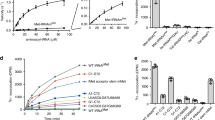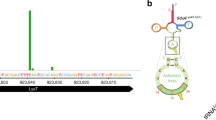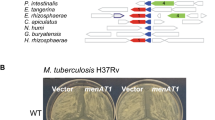Abstract
Toxin–antitoxin (TA) loci are prevalent in bacterial genomes. They are suggested to play a central role in dormancy and persister states. Under normal growth conditions, TA toxins are neutralized by their cognate antitoxins, and under stress conditions, toxins are freed and inhibit essential cellular processes using a variety of mechanisms. Here we characterize ataR–ataT, a novel TA system, from enterohemorrhagic Escherichia coli. We show that the toxin AtaT is a GNAT family enzyme that transfers an acetyl group from acetyl coenzyme A to the amine group of the methionyl aminoacyl moiety of initiator tRNA. AtaT specifically modifies Met-tRNAfMet, but no other aminoacyl-tRNAs, including the elongator Met-tRNAMet. We demonstrate that once acetylated, AcMet-tRNAfMet fails to interact with initiation factor-2 (IF2), resulting in disruption of the translation initiation complex. This work reveals a new mechanism of translation inhibition and confirms Met-tRNAfMet as a prime target to efficiently block cell growth.
This is a preview of subscription content, access via your institution
Access options
Access Nature and 54 other Nature Portfolio journals
Get Nature+, our best-value online-access subscription
$29.99 / 30 days
cancel any time
Subscribe to this journal
Receive 12 print issues and online access
$259.00 per year
only $21.58 per issue
Buy this article
- Purchase on Springer Link
- Instant access to full article PDF
Prices may be subject to local taxes which are calculated during checkout






Similar content being viewed by others
Accession codes
References
Leplae, R. et al. Diversity of bacterial type II toxin-antitoxin systems: a comprehensive search and functional analysis of novel families. Nucleic Acids Res. 39, 5513–5525 (2011).
Makarova, K.S., Wolf, Y.I. & Koonin, E.V. Comprehensive comparative-genomic analysis of type 2 toxin-antitoxin systems and related mobile stress response systems in prokaryotes. Biol. Direct 4, 19 (2009).
Pandey, D.P. & Gerdes, K. Toxin-antitoxin loci are highly abundant in free-living but lost from host-associated prokaryotes. Nucleic Acids Res. 33, 966–976 (2005).
Magnuson, R.D. Hypothetical functions of toxin-antitoxin systems. J. Bacteriol. 189, 6089–6092 (2007).
Van Melderen, L. Toxin-antitoxin systems: why so many, what for? Curr. Opin. Microbiol. 13, 781–785 (2010).
Maisonneuve, E. & Gerdes, K. Molecular mechanisms underlying bacterial persisters. Cell 157, 539–548 (2014).
Brauner, A., Fridman, O., Gefen, O. & Balaban, N.Q. Distinguishing between resistance, tolerance and persistence to antibiotic treatment. Nat. Rev. Microbiol. 14, 320–330 (2016).
Yamaguchi, Y. & Inouye, M. Regulation of growth and death in Escherichia coli by toxin-antitoxin systems. Nat. Rev. Microbiol. 9, 779–790 (2011).
Hayes, F. & Van Melderen, L. Toxins-antitoxins: diversity, evolution and function. Crit. Rev. Biochem. Mol. Biol. 46, 386–408 (2011).
Mutschler, H., Gebhardt, M., Shoeman, R.L. & Meinhart, A. A novel mechanism of programmed cell death in bacteria by toxin-antitoxin systems corrupts peptidoglycan synthesis. PLoS Biol. 9, e1001033 (2011).
Bernard, P. & Couturier, M. Cell killing by the F plasmid CcdB protein involves poisoning of DNA-topoisomerase II complexes. J. Mol. Biol. 226, 735–745 (1992).
Jiang, Y., Pogliano, J., Helinski, D.R. & Konieczny, I. ParE toxin encoded by the broad-host-range plasmid RK2 is an inhibitor of Escherichia coli gyrase. Mol. Microbiol. 44, 971–979 (2002).
Harms, A. et al. Adenylylation of gyrase and topo IV by FicT toxins disrupts bacterial DNA topology. Cell Rep. 12, 1497–1507 (2015).
Goeders, N., Drèze, P.L. & Van Melderen, L. Relaxed cleavage specificity within the RelE toxin family. J. Bacteriol. 195, 2541–2549 (2013).
Pedersen, K. et al. The bacterial toxin RelE displays codon-specific cleavage of mRNAs in the ribosomal A site. Cell 112, 131–140 (2003).
Zhang, Y. et al. MazF cleaves cellular mRNAs specifically at ACA to block protein synthesis in Escherichia coli. Mol. Cell 12, 913–923 (2003).
Winther, K.S. & Gerdes, K. Enteric virulence associated protein VapC inhibits translation by cleavage of initiator tRNA. Proc. Natl. Acad. Sci. USA 108, 7403–7407 (2011).
Winther, K.S., Brodersen, D.E., Brown, A.K. & Gerdes, K. VapC20 of Mycobacterium tuberculosis cleaves the sarcin-ricin loop of 23S rRNA. Nat. Commun. 4, 2796 (2013).
Germain, E., Castro-Roa, D., Zenkin, N. & Gerdes, K. Molecular mechanism of bacterial persistence by HipA. Mol. Cell 52, 248–254 (2013).
Kaspy, I. et al. HipA-mediated antibiotic persistence via phosphorylation of the glutamyl-tRNA-synthetase. Nat. Commun. 4, 3001 (2013).
Castro-Roa, D. et al. The Fic protein Doc uses an inverted substrate to phosphorylate and inactivate EF-Tu. Nat. Chem. Biol. 9, 811–817 (2013).
Garcia-Pino, A. et al. Doc of prophage P1 is inhibited by its antitoxin partner Phd through fold complementation. J. Biol. Chem. 283, 30821–30827 (2008).
Vetting, M.W. et al. Structure and functions of the GNAT superfamily of acetyltransferases. Arch. Biochem. Biophys. 433, 212–226 (2005).
Cheverton, A.M. et al. A Salmonella toxin promotes persister formation through acetylation of tRNA. Mol. Cell 63, 86–96 (2016).
Iqbal, N., Guérout, A.M., Krin, E., Le Roux, F. & Mazel, D. Comprehensive functional analysis of the 18 Vibrio cholerae N16961 toxin-antitoxin systems substantiates their role in stabilizing the superintegron. J. Bacteriol. 197, 2150–2159 (2015).
Dao-Thi, M.H. et al. Intricate interactions within the ccd plasmid addiction system. J. Biol. Chem. 277, 3733–3742 (2002).
Overgaard, M., Borch, J., Jørgensen, M.G. & Gerdes, K. Messenger RNA interferase RelE controls relBE transcription by conditional cooperativity. Mol. Microbiol. 69, 841–857 (2008).
Garcia-Pino, A. et al. Allostery and intrinsic disorder mediate transcription regulation by conditional cooperativity. Cell 142, 101–111 (2010).
Afif, H., Allali, N., Couturier, M. & Van Melderen, L. The ratio between CcdA and CcdB modulates the transcriptional repression of the ccd poison-antidote system. Mol. Microbiol. 41, 73–82 (2001).
Loris, R. & Garcia-Pino, A. Disorder- and dynamics-based regulatory mechanisms in toxin-antitoxin modules. Chem. Rev. 114, 6933–6947 (2014).
Neuwald, A.F. & Landsman, D. GCN5-related histone N-acetyltransferases belong to a diverse superfamily that includes the yeast SPT10 protein. Trends Biochem. Sci. 22, 154–155 (1997).
Ikeuchi, Y., Kitahara, K. & Suzuki, T. The RNA acetyltransferase driven by ATP hydrolysis synthesizes N4-acetylcytidine of tRNA anticodon. EMBO J. 27, 2194–2203 (2008).
Grosjean, H., Keith, G. & Droogmans, L. Detection and quantification of modified nucleotides in RNA using thin-layer chromatography. Methods Mol. Biol. 265, 357–391 (2004).
Schuber, F. & Pinck, M. On the chemical reactivity of aminoacyl-tRNA ester bond. I. Influence of pH and nature of the acyl group on the rate of hydrolysis. Biochimie 56, 383–390 (1974).
Janssen, B.D., Diner, E.J. & Hayes, C.S. Analysis of aminoacyl- and peptidyl-tRNAs by gel electrophoresis. Methods Mol. Biol. 905, 291–309 (2012).
Mitkevich, V.A. et al. Thermodynamic characterization of ppGpp binding to EF-G or IF2 and of initiator tRNA binding to free IF2 in the presence of GDP, GTP, or ppGpp. J. Mol. Biol. 402, 838–846 (2010).
Tsai, A. et al. Heterogeneous pathways and timing of factor departure during translation initiation. Nature 487, 390–393 (2012).
Neubauer, C. et al. The structural basis for mRNA recognition and cleavage by the ribosome-dependent endonuclease RelE. Cell 139, 1084–1095 (2009).
Vetting, M.W., Bareich, D.C., Yu, M. & Blanchard, J.S. Crystal structure of RimI from Salmonella typhimurium LT2, the GNAT responsible for N(alpha)-acetylation of ribosomal protein S18. Protein Sci. 17, 1781–1790 (2008).
Tanaka, S., Matsushita, Y., Yoshikawa, A. & Isono, K. Cloning and molecular characterization of the gene rimL which encodes an enzyme acetylating ribosomal protein L12 of Escherichia coli K12. Mol. Gen. Genet. 217, 289–293 (1989).
Yoshikawa, A., Isono, S., Sheback, A. & Isono, K. Cloning and nucleotide sequencing of the genes rimI and rimJ which encode enzymes acetylating ribosomal proteins S18 and S5 of Escherichia coli K12. Mol. Gen. Genet. 209, 481–488 (1987).
Sprink, T. et al. Structures of ribosome-bound initiation factor 2 reveal the mechanism of subunit association. Sci. Adv. 2, e1501502 (2016).
Guenneugues, M. et al. Mapping the fMet-tRNA(f)(Met) binding site of initiation factor IF2. EMBO J. 19, 5233–5240 (2000).
Milon, P. et al. The ribosome-bound initiation factor 2 recruits initiator tRNA to the 30S initiation complex. EMBO Rep. 11, 312–316 (2010).
Winther, K., Tree, J.J., Tollervey, D. & Gerdes, K. VapCs of Mycobacterium tuberculosis cleave RNAs essential for translation. Nucleic Acids Res. 44, 9860–9871 (2016).
Garcia-Pino, A., Zenkin, N. & Loris, R. The many faces of Fic: structural and functional aspects of Fic enzymes. Trends Biochem. Sci. 39, 121–129 (2014).
Kitagawa, M. et al. Complete set of ORF clones of Escherichia coli ASKA library (a complete set of E. coli K-12 ORF archive): unique resources for biological research. DNA Res. 12, 291–299 (2005).
Buck, M., Connick, M. & Ames, B.N. Complete analysis of tRNA-modified nucleosides by high-performance liquid chromatography: the 29 modified nucleosides of Salmonella typhimurium and Escherichia coli tRNA. Anal. Biochem. 129, 1–13 (1983).
Castro-Roa, D. & Zenkin, N. Methods for the assembly and analysis of in vitro transcription-coupled-to-translation systems. Methods Mol. Biol. 1276, 81–99 (2015).
Walker, S.E. & Fredrick, K. Preparation and evaluation of acylated tRNAs. Methods 44, 81–86 (2008).
Sobott, F., Hernández, H., McCammon, M.G., Tito, M.A. & Robinson, C.V. A tandem mass spectrometer for improved transmission and analysis of large macromolecular assemblies. Anal. Chem. 74, 1402–1407 (2002).
Korber, P., Stahl, J.M., Nierhaus, K.H. & Bardwell, J.C. Hsp15: a ribosome-associated heat shock protein. EMBO J. 19, 741–748 (2000).
Acknowledgements
D.J. is a PhD fellow at the Fonds National de la Recherche Scientifique (aspirant FNRS). This work was supported by grants from the Fonds Jean Brachet and the Fondation Van Buuren to L.D.; from the FNRS (grant number F.4505.16 MIS), the Fonds d'Encouragement à la Recherche ULB (FER-ULB), the Fonds Jean Brachet and the Fondation Van Buuren to A.G.P.; and from the FNRS (grant number 3.4621.12 FRSM, T.0147.15F PDR and J.0061.16F CDR), the Interuniversity Attraction Poles Program initiated by the Belgian Science Policy Office (MICRODEV), the Fonds Jean Brachet and the Fondation Van Buuren to L.V.M. The authors would like to thank J.M. Sanz for initial work in characterizing the ataR–ataT system.
Author information
Authors and Affiliations
Contributions
D.J., L.D., A.G.P. and L.V.M. designed research; D.J., A.G.P., A.K. and S.C. performed research; D.J., A.K., S.C., F.S., L.D., A.G.-P. and L.V.M. analyzed data; and D.J., A.G.-P. and L.V.M. wrote the paper.
Corresponding authors
Ethics declarations
Competing interests
The authors declare no competing financial interests.
Supplementary information
Supplementary Text and Figures
Supplementary Results, Supplementary Tables 1, 2, and Supplementary Figures 1–12 (PDF 5663 kb)
Rights and permissions
About this article
Cite this article
Jurėnas, D., Chatterjee, S., Konijnenberg, A. et al. AtaT blocks translation initiation by N-acetylation of the initiator tRNAfMet. Nat Chem Biol 13, 640–646 (2017). https://doi.org/10.1038/nchembio.2346
Received:
Accepted:
Published:
Issue Date:
DOI: https://doi.org/10.1038/nchembio.2346
This article is cited by
-
Direct measurements of mRNA translation kinetics in living cells
Nature Communications (2022)
-
Biology and evolution of bacterial toxin–antitoxin systems
Nature Reviews Microbiology (2022)
-
Mutations in respiratory complex I promote antibiotic persistence through alterations in intracellular acidity and protein synthesis
Nature Communications (2022)
-
Identification of Type II Toxin-Antitoxin Loci in Levilactobacillus brevis
Interdisciplinary Sciences: Computational Life Sciences (2022)
-
Auxiliary interfaces support the evolution of specific toxin–antitoxin pairing
Nature Chemical Biology (2021)



